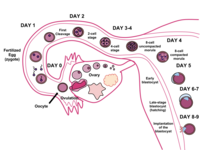
Photo from wikipedia
Normal human pregnancy requires a dramatic increase in uteroplacental blood flow which is achieved by a transformation in the geometry of uterine spiral arteries, a key element in this blood… Click to show full abstract
Normal human pregnancy requires a dramatic increase in uteroplacental blood flow which is achieved by a transformation in the geometry of uterine spiral arteries, a key element in this blood supply system. The transformation is mediated by trophoblast invasion directed at converting a portion of the spiral artery into an open funnel, thereby greatly reducing resistance to flow. The converted portion lies within the depth of the decidua and part of the myometrium. Insufficient depth of trophoblast invasion in early pregnancy predisposes to inadequate perfusion of the developing placenta andfetus and may lead to preeclampsia, fetal growth restriction and preterm delivery, sometimes referred to as the "Great Obstetrical Syndromes". We examine the hemodynamic consequences of spiral artery transformation in human pregnancy and the relationship between the degree of transformation and the corresponding change in flow rate and resistance to flow. We identify two key variables in determining the hemodynamic change: the longitudinal converted fraction of the spiral artery and the relative downstream diameterof the open funnel. Our results indicate that there is a critical threshold in the value of the converted fraction required to achieve the marked increase in uteroplacental blood flow in normal pregnancy. This finding validates common clinical observations that the depth of trophoblast invasion reflects the "adequacy" of the increase in uteroplacental blood supply required in normal human pregnancy. Our results provide a quantitative measure of that adequacy and may serve as a future diagnostic marker for high-risk pregnancy.
Journal Title: Journal of applied physiology
Year Published: 2020
Link to full text (if available)
Share on Social Media: Sign Up to like & get
recommendations!